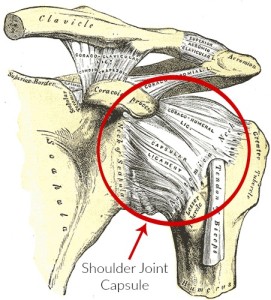How to treat frozen shoulder
Today on the Fit Stop Blog I would like to discuss one of the most painful conditions that I see regularly – the dreaded, miserable, absolutely debilitating – frozen shoulder (FS), (AKA adhesive capsulitis). Now, FS is truly a painful son of a gun. Growing up as the son of a physical therapist, I used to observe my father from time to time in the clinic. I remember watching him work with these poor patients who had FS, and they would be in tears from the stretching. I used to think to myself, well, that doesn’t look like a whole lot of fun, for either patient or therapist! I wondered if the field of PT was really for me after observing some of those treatments. Well, fast forward a few years later, and here I am blogging about this all-too-common condition. FS is a very interesting condition, and actually not very well understood. Today, I will discuss what it is, and why we think certain people actually get it.
What is Frozen Shoulder?
 Frozen Shoulder is better understood if we break down the meaning of its official name, adhesive capsulitis. The capsule of the shoulder joint is basically a ligament like envelope that connects the arm bone (humerus) to the shoulder blade (scapula). The job of the capsule is to provide a connection for the two bones and to provide a lubricating effect to the joint, as it produces synovial fluid or lubricating fluid for the joint. This capsule can sometimes become irritated and inflamed (as will be discussed in the WHY section), resulting in a capsulitis (inflammation of the capsule). This inflammation can sometimes progress, and worsen to the point of causing hardening and tightening of the capsule, thus the term “adhesive”. At this advanced phase, the hardened capsule causes a real significant tightening effect on the shoulder joint resulting in a major loss in shoulder movement.
Frozen Shoulder is better understood if we break down the meaning of its official name, adhesive capsulitis. The capsule of the shoulder joint is basically a ligament like envelope that connects the arm bone (humerus) to the shoulder blade (scapula). The job of the capsule is to provide a connection for the two bones and to provide a lubricating effect to the joint, as it produces synovial fluid or lubricating fluid for the joint. This capsule can sometimes become irritated and inflamed (as will be discussed in the WHY section), resulting in a capsulitis (inflammation of the capsule). This inflammation can sometimes progress, and worsen to the point of causing hardening and tightening of the capsule, thus the term “adhesive”. At this advanced phase, the hardened capsule causes a real significant tightening effect on the shoulder joint resulting in a major loss in shoulder movement.
Why does it happen?
This is actually a very interesting question because there is a bit of mystery involved with frozen shoulder; oftentimes there is no apparent reason why people develop it. However, there are a few common factors that often seem to be associated with frozen shoulder. The following may play a hand in the development of this condition:
* Trauma: It is thought that even minor traumatic events, such as a mere bump into a wall, or a fall that causes a little pain, can start the development of frozen shoulder. When somebody has a an episode like this, the tendency is then to protect the shoulder by not moving it as is usual. This combination of some inflammation from the trauma and lack of movement, can lead to the process described above.
* Hormones: Women are much more likely to develop a frozen shoulder, so the hormone balance in females may have something to do with its onset. When females experience a traumatic event like a fall or a surgical procedure it can predispose the individual to develop frozen shoulder.
* Diabetes: Diabetics are at an elevated risk of developing frozen shoulder. Diabetics who have shoulder trauma or surgery, should be careful to take steps to avoid developing a frozen shoulder.
What do we do about it?
What are some steps that can be taken, especially for those who may be at an increased risk, to help prevent the pain that comes along with frozen shoulder? First and foremost – remember to keep that shoulder moving! With most minor shoulder sprains or strains it is a good idea to work consistently on simple range of motion exercises following the injury. Click on the image below to get instruction regarding four of my favorite exercises to maintain shoulder mobility and range of motion:
Following a minor sprain or strain, performing these exercises 3-5 times a day is an excellent idea. Trust me, having a little pain doing these exercises is much better than dealing with the intense pain and long duration of frozen shoulder. Frozen shoulder can sometimes take as long as 1-2 years to be completely resolved. So keep these exercises in mind and keep that shoulder moving.
If you suspect you may have frozen shoulder, or have any questions about shoulder pain, don’t hesitate to give us a call at the Fit Stop. There is a lot physical therapy can do to help alleviate shoulder pain that comes along with frozen shoulder.
Heber City Salt Lake Farmington Murray
Toby Bluth, PT, DPT
Fit Stop Physical Therapy – Heber City
345 West 600 South Suite 200
Heber City, UT 84032
(435) 654-5607



